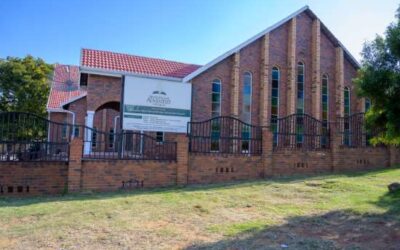Seventh-day Adventists are a Protestant Christian denomination who hold to the biblical seventh-day Sabbath. From this belief, they get the first part of their name.
Early founders named it “The Seventh-day Adventist Church” to highlight their beliefs in the seventh-day Sabbath, and the Second Advent, or Second Coming of Christ.
Once the Church started to gain more momentum, its headquarters were moved from Battle Creek Michigan to Silver Spring, Maryland in 1989.2
Today, the Adventist Church is a worldwide Protestant Christian denomination with nearly 22 million baptized members. It has churches of all sizes, as well as schools, hospitals, media and publishing houses, relief agencies, and various service ministries around the world.
But how did we get to this point?
Seventh-day Adventism has a rich history of sincere Bible study and a collective ambition to share the hope found in Jesus Christ.
To give you an overview of its origins and growth, we’ll highlight the major milestones:
- The Advent Movement that paved the way
- Ellen White and the growth of Seventh-day Adventism
- Mission work and global expansion
- Our official statement of belief
To get the full picture of how the Adventist Church began, we have to go back a few decades before it started.
The Advent Movement that paved the way

Photo by Priscilla Du Preez on Unsplash
Seventh-day Adventists’ origins can be traced all the way back to the 1830s, when a farmer, military veteran, and preacher named William Miller wanted to deepen his understanding of the Bible.
His return from war was a reminder of just how precious but short life really is. With this in mind, he turned his attention to studying the prophecies found in Daniel and Revelation. It didn’t take long for Miller to conclude that Jesus’ second coming was a literal event—and it might be happening much sooner than many thought.
Not wanting to lead anyone astray, Miller didn’t speak up right away. He studied for nine more years until he could no longer stifle his conviction. It was time to tell the world.
The Millerite Movement
Miller’s study of the 2300-day prophecy in Daniel 8 and 9 convinced him that the Second Advent (the second coming of Christ) was right around the corner—in 1843 or 1844. Eventually, his follower Samuel Snow set a more specific date: October 22nd, 1844.
This prediction gained traction, and the movement grew in both size and enthusiasm. Followers mostly came from existing churches. They were Methodists, Presbyterians, and Episcopalians.
At that time, their belief in the soon coming of Christ was radical. As a result, many of the existing churches removed these people from membership.
So they came together and called themselves the Millerites, and they excitedly anticipated the predicted date.
As the morning of October 22nd approached, each believer had been preparing for the Second Coming.
They spent time in prayer, they sold their properties, and some even left their farms’ harvests sitting in the fields. They eagerly awaited the first sight of Jesus and a host of angels. Many probably stayed up late, waiting for the clock to strike midnight, thinking Jesus might make His appearance at the very last second.
The Great Disappointment
But midnight passed. The hours had slowly ticked by, but nothing happened.
That’s why October 22nd, 1844, has since become known as the Great Disappointment.
It’s true that the Bible gives us incredible insight about the future of humanity. But when we’re tempted to go overboard in trying to figure everything out, right down to the last detail, Scripture includes some warnings—even specifically about predicting the exact date and time of the Second Coming:
“But of that day and hour no one knows, not even the angels of heaven, but My Father only” (Matthew 24:36, NKJV).
“Therefore, you also be ready, for the Son of Man is coming at an hour you do not expect” (Matthew 24:44, NKJV).
These truths didn’t stand out to the Millerites, or they were interpreted differently. But that changed after the Great Disappointment. With time, many disheartened but persevering Christians recognized where they went wrong.
Those who were committed to going back to the Bible found a way forward.
Carrying on in faith
After the Disappointment, many Millerites gave up their newfound hope and returned to their normal lives. But others dove into their Bibles, wondering where they went wrong—and they found answers.
They learned that the Bible passage in Daniel 8:14 didn’t point to the second coming of Jesus, but to His ministry in the Most Holy Place of the sanctuary in heaven. It also marked the beginning of the investigative judgment for all professed believers throughout history.
While they maintained their belief in Jesus’ soon return, they also embraced the new truth about the heavenly sanctuary.
Then, an influential Millerite named Joseph Bates found out that according to the Bible, the Sabbath is on Saturday, not Sunday. He learned this from Seventh-day Baptists. And after much Bible study, he was convinced and went on to share the truth with fellow Millerites, including James and Ellen White.
Soon, they too were convinced of the biblical seventh-day Sabbath. Later, these three would become some of the leading founders of Seventh-day Adventism.
As they shared the Sabbath truth among the scattered groups, those who accepted it came to be known as Sabbatarian Adventists.
Further Bible studies led to the discovery of other biblical teachings like:
- The dead are asleep until the Second Coming
- In the last days, Christians will be called back to biblical truth, and a small group of believers will answer the call (Revelation 14)
- Many will display the prophetic gift in the last days and proclaim the good news about Jesus to the world (Joel 2:28; Acts 2:17)
These beliefs were quite different from what other Christian denominations of the time taught. But Adventists believe in what we call present truth—truths from the Bible that are relevant to a specific time and context and may not have been known in earlier times.
And since this new understanding of the Bible often set the members of the movement at odds with other churches, they ended up forming their own denomination in 1860 with the name “Seventh-day Adventist.”
Three years later, in 1863, the denomination was officially organized as the General Conference of Seventh-day Adventists.
The Church started out in North America with its headquarters in Battle Creek, Michigan.
But soon, it grew beyond North America, and an elaborate church structure developed.
Let’s see how that growth happened.
Ellen White and the growth of Seventh-day Adventism

Courtesy of the Ellen G. White Estate, Inc.
Two of the most influential founders of the Seventh-day Adventist Church were Ellen G. White and her husband, James White.
She is recognized by the Church as one who exhibited the prophetic gift (Romans 12:6; 1 Corinthians 14), although she did not claim the title of “prophet” for herself.
She helped shape the early years of Adventism by writing and speaking the things God impressed her with.
Through guidance and wisdom from the Holy Spirit, Ellen White spearheaded several initiatives in the Adventist Church like:
- The publishing work—beginning with the Present Truth periodical that started in Rochester, New York, under the leadership of James White (1849)
- The health work—beginning with the Battle Creek Sanitarium under the leadership of John Harvey Kellogg (1866)
- The Adventist educational system—beginning with Goodloe Harper Bell’s school in Battle Creek (1872)
Inspired by the Great Commission in Matthew 28:19–20, Adventists grew from these humble beginnings to the worldwide denomination that we know today.
But to get to that point, they engaged in widespread evangelistic initiatives and overseas missions.
Mission work and global expansion

Courtesy of the Ellen G. White Estate, Inc.
In 1874, the Church decided to sponsor the very first Adventist overseas missionary to Europe: J. N. Andrews.
There, he established a publishing house in Switzerland, planted congregations, and put together an organizational structure for the Church in Europe.
This began Adventist overseas missions. Soon, missionaries were sent out to share the gospel. And the Church spread all over Europe, South America, Australia, Africa, Asia, and other parts of the world.
And wherever the Church’s missionary work went, the publishing, health, and educational work also did.
As part of their mission to share the love of Jesus with the world, Adventists provided education, healthcare, and other essential infrastructure to support local communities. The result was an extensive network of Adventist institutions around the world.
By 1901, there were 75,000 church members worldwide. In addition, the Church had established two colleges, a medical school, 12 secondary schools, 27 hospitals, and 13 publishing houses.
With the growing numbers and geographical scope of Adventism, it became necessary to reorganize the administrative structure of the Church.
That’s how we ended up with the structure that exists today.
We have the General Conference (GC) as the highest administrative level, overseeing the global Church. The GC has various departments like Communications, Education, Sabbath School, Religious Liberty, and Youth Ministries.
The GC consists of divisions that cover different world regions. And the divisions are made up of union conferences, which are made up of local conferences. At the lowest level, we have local churches within those conferences.
After this structural reorganization, the Church’s headquarters, together with the first denominational publishing house (the Review and Herald Publishing Association), was moved from Battle Creek to Takoma Park, Maryland, near Washington, DC. Today, it’s located in Silver Spring, Maryland.
As of 2021, there are 95,297 Adventist Churches worldwide with a total of 21,912,161 church members.
Overview timeline of the early Adventist Church
- 1790–1840: Second Great Awakening in the United States
- 1831: War-veteran-turned-preacher William Miller deepens his studies and begins preaching about his new discoveries in Scripture
- 1839: Joseph Bates joins William Miller’s movement, the Millerites, focusing on how the “Second Advent,” or second coming of Jesus, is near
- 1844, Oct. 22: The Great Disappointment—William Miller misinterprets prophetic statements in Daniel and Revelation, thinking Jesus would return on this date.
- 1845: J. N. Andrews (namesake of Andrews University) accepts Miller’s teachings on the seventh-day Sabbath
- 1846: Joseph Bates publishes an article on the biblical seventh-day Sabbath, which convicts James and Ellen White
- 1849: James White begins publishing a periodical that’s now called the Adventist Review
- 1851: Ellen White publishes her first book: A Sketch of the Christian Experience and Views of Ellen G. White
- 1852: First Adventist printing press is established in Rochester, New York
- 1855: Biblical research supports the Sabbath timing, beginning sunset Friday and ending sunset Saturday
- 1860, Oct. 1: Delegates name the denomination “Seventh-day Adventist”
- 1863: General Conference of Seventh-day Adventists is established
- 1866: First Adventist-owned and operated medical institution is established
- 1868: First Adventist camp meeting is held
- 1872: Opening of first Adventist-sponsored school
- 1874: Opening of first Adventist college
- 1874: General Conference launches their educational society
- 1874: J. N. Andrews leaves on his first mission trip to Europe
- 1879: Adventist membership reaches 16,000
- 1888: The Great Controversy is first published
- 1901: Adventist membership reaches 75,000
Adventism’s official statement of beliefs
Adventism’s early history focuses on some specific biblical beliefs that made it stand out from other Christian churches at the time. But it’s important to remember that the foundation of all our beliefs rests on Jesus Christ as our Savior and the wealth of truth found in the Bible.
Our goal is to share Jesus’ love throughout the world so we can all joyfully anticipate His soon return.
In 1980, the General Conference produced the church’s first official statement of beliefs, voted by members from across the world. It became known as the 27 Fundamental Beliefs.
This statement of beliefs was not established as a “creed,” which is an established teaching or interpretation by an authoritative church body. Instead, its purpose is to summarize how Adventists interpret the key themes of Scripture and to leave room for God to reveal more truth through Bible study.
These beliefs are reviewed at each General Conference session. And in 2005, a new belief (#11) was added to the list.
The 28 Fundamental Beliefs are:
- The Holy Scriptures
- The Trinity
- God the Father
- God the Son (Jesus Christ)
- God the Holy Spirit
- Creation
- Nature of Humanity
- The Great Controversy
- The Life, Death, and Resurrection of Christ
- The Experience of Salvation
- Growing in Christ
- The Church
- The Remnant and Its Mission
- Unity in the Body of Christ
15. Baptism
16. The Lord’s Supper (Communion)
17. Spiritual Gifts and Ministries
18. The Gift of Prophecy
19. The Law of God
20. The Sabbath
21. Stewardship
22. Christian Behavior
23. Marriage and the Family
24. Christ’s Ministry in the Heavenly Sanctuary
25. The Second Coming of Christ
26. Death and Resurrection
27. The Millennium and the End of Sin
28. The New Earth
Adventist history still in the making
What a journey we have been on together! Starting out in 1830 with a humble farmer that found renewed hope in Scripture, we’ve tracked Adventism’s progress to the present day. Who would have thought that it would’ve come so far in such a short time?
From the beginning, the Adventist faith has been rooted in the continued study of the Word of God. Every foundation was studied thoroughly and prayerfully by the founders of our church.
They would’ve never imagined just how much of an impact their discoveries have made in people’s lives.
As a group of human believers, we have had our fair share of conflicts, but God has been with us every step of the way. And as we continue to move forward, we pray that our church leaders will continue to seek wisdom from Jesus and the Bible, just as our founders did.
Our work isn’t finished yet. Many people across the world are still longing for God’s love and the assurance that He is coming back for us.
So our history has not and will not end until the moment we’re all waiting for—when Jesus returns to earth, when sin and Satan will be destroyed, and when we can live with God for eternity.
Related Articles
- “Seventh-Day Adventists,” Encyclopedia of Arkansas, https://encyclopediaofarkansas.net/entries/seventh-day-adventists-5985/.[↵]
- Knight, George, R., A Brief History of Seventh-day Adventists, p. 120. [↵]
More Answers
William Miller
William Miller was a farmer in the early 1800s who gave his life to God and began intensely studying his Bible.
Joseph Bates
Joseph Bates was a sailor-turned-preacher who joined the Millerite Movement and waited for Jesus to come in 1844. Despite being disappointed when this didn’t occur, Bates held onto his faith and played an enthusiastic and integral part in starting the Seventh-day Adventist Church.
Who was J.N. Andrews and How Did He Contribute to Adventism?
John Nevins Andrews (1829–1883) was an influential leader in the early days of the Seventh-day Adventist Church. He was a Bible scholar who helped shape several Adventist beliefs and juggled many roles in the Church. Most notably, he was the first official missionary for the Adventist Church outside North America.
Seventh-day Adventist Founders
The key figures and founders of Seventh-day Adventism were a group of people from various Protestant Christian denominations who were committed to studying the Word of God and sharing about Jesus Christ.
The Millerite Movement
The Millerite Movement was a religious revival that started in 1831 when the Baptist preacher William Miller, an earnest student of the Bible, began preaching and writing about the soon return of Christ. Due to a misinterpretation of a prophecy in the book of Daniel, he and his followers concluded that Jesus Christ was coming back sometime around 1843 or 1844.
What is the Great Disappointment and What Can We Learn From It?
On October 22, 1844, thousands of Christians in the Northeastern United States eagerly watched the skies for what they believed would be the second coming of Jesus Christ.
Who Was James Springer White?
James Springer White (1821–1881) was a key figure in the Seventh-day Adventist Church and the husband of Ellen G. White.
Didn’t find your answer? Ask us!
We understand your concern of having questions but not knowing who to ask—we’ve felt it ourselves. When you’re ready to learn more about Adventists, send us a question! We know a thing or two about Adventists.















